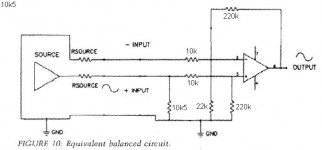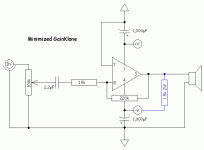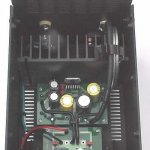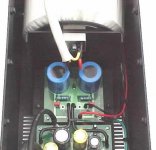Hi,
Any Op-Amp can "accept" balanced Inputs. Though just because it CAN be done does not mean it provides advantages.
I suspect you would do it one of the usual ways. the best solution of course is a suitable input transformer. That failing make the usual pseudo balanced input. Nelson Pass has used it a lot, it's described and shown as part of the A75 Article, part 1 page 12:
http://www.passdiy.com/pdf/A75p1.pdf
Sayonara
Since the LM3875 seems to accept balanced inputs
Any Op-Amp can "accept" balanced Inputs. Though just because it CAN be done does not mean it provides advantages.
does anyone have an idea how the Thor/Peter Daniel minimised gainclone can be converted to balanced input?
I suspect you would do it one of the usual ways. the best solution of course is a suitable input transformer. That failing make the usual pseudo balanced input. Nelson Pass has used it a lot, it's described and shown as part of the A75 Article, part 1 page 12:
http://www.passdiy.com/pdf/A75p1.pdf
Sayonara
Hi,
I have worked very extensively with Chip Amp's and Op-Amp's in the 1980's when the "Gaincard" was a gleam in Kimura San's eye, mostly Pro-Audio design. A good deal DIY too, including fully active speakers with Motional Feedback on woofers and currentdrive on midrange/fullrange and tweeter, all Amp Chips (TDA2030) inverting with a "boosted bridge" circuit with TDA2030A on the woofers, subtractive crossovers and so on....
Later I did a lot of servicing HiFi/High End gear, much of this chips galore too.
These days I use Valves out of esthetical choice and nostalgia as much as for sound reasons. I still occasionally mess about with Chips, but rarely. I paid my "lehrgeld" with oscillation,circuits and all sorts of theoretical and practical issues in those long forgotten days over 15 years ago, though little has changed since then, so all this "old fogey stuff" still holds up well...
Sayonara
Do you have any pictures of gainclones you've built?
I have worked very extensively with Chip Amp's and Op-Amp's in the 1980's when the "Gaincard" was a gleam in Kimura San's eye, mostly Pro-Audio design. A good deal DIY too, including fully active speakers with Motional Feedback on woofers and currentdrive on midrange/fullrange and tweeter, all Amp Chips (TDA2030) inverting with a "boosted bridge" circuit with TDA2030A on the woofers, subtractive crossovers and so on....
Later I did a lot of servicing HiFi/High End gear, much of this chips galore too.
These days I use Valves out of esthetical choice and nostalgia as much as for sound reasons. I still occasionally mess about with Chips, but rarely. I paid my "lehrgeld" with oscillation,circuits and all sorts of theoretical and practical issues in those long forgotten days over 15 years ago, though little has changed since then, so all this "old fogey stuff" still holds up well...
Sayonara
Please forgive me Kuei Yang Wang but I'm a bit of a newbie.
Do you mean that I can drive the op-amp as is with a balanced signal from a balanced pre-amp as long as the input impedance of + and - signals is equal?
So I just add a resistor to the other signal line of Peter Daniels gainclone and I'm done?
Why wouldn't I want to drive the amp this way? You seem to have some doubts on whether balanced operation is suitable.
Do you mean that I can drive the op-amp as is with a balanced signal from a balanced pre-amp as long as the input impedance of + and - signals is equal?
So I just add a resistor to the other signal line of Peter Daniels gainclone and I'm done?
Why wouldn't I want to drive the amp this way? You seem to have some doubts on whether balanced operation is suitable.
PS....
Here my latest "clone". It's not really a clone, but these SE 300B Amp's are inspired by Gordon Rankins Triton/Napoleon Style Amp based on the Chassis and iron of the DIY HiFisupply "Billie" Kits....
Modestly obliges me however to say that many features in this amplifier are my own and have nothing to do with Gordons Amplifiers. What I did nick from him are the Gridchok on the output valve and the use of the 437A as driver with an input transformer that offers up to 12db passive gain....
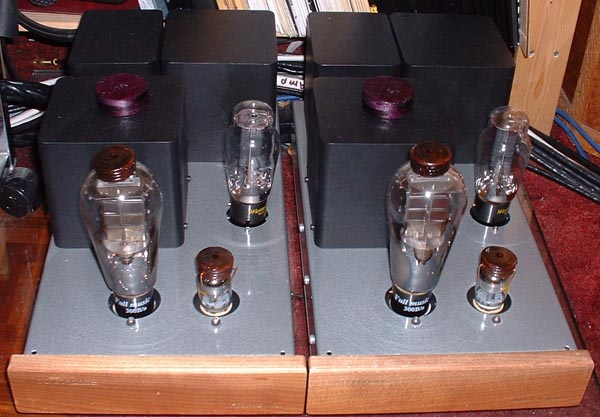
Sayonara
PS, these amp's sound a LOT better than a friends inverted, battery powered Gainclones, but so they should for the investment and design....
Here my latest "clone". It's not really a clone, but these SE 300B Amp's are inspired by Gordon Rankins Triton/Napoleon Style Amp based on the Chassis and iron of the DIY HiFisupply "Billie" Kits....
Modestly obliges me however to say that many features in this amplifier are my own and have nothing to do with Gordons Amplifiers. What I did nick from him are the Gridchok on the output valve and the use of the 437A as driver with an input transformer that offers up to 12db passive gain....

An externally hosted image should be here but it was not working when we last tested it.
Sayonara
PS, these amp's sound a LOT better than a friends inverted, battery powered Gainclones, but so they should for the investment and design....
So they are the ultimatisch amps for you?
these amp's sound a LOT better than a friends inverted, battery powered Gainclones
Sound better how?
Hi,
Okay. I have redrawn Nelsons Schematic a little (no Circuit Drawing program at hand here) to clarify the application to an inverted gainclone (including the "unconditionally stability resistor").
I in general do not feel that balanced connections offer advantages, UNLESS they are executed using transformer coupling. Note also that I called the input type shown here and described by Nelson Pass as "pseudo balanced", indicating that it does not operate fully like a balanced (transformer) input.
In many cases the balanced outputs of preamplifiers incorporate extra circuitry over unbalanced outputs which usually do not help the sound. In my own system I use balanced Inputs and Outputs EXTENSIVELY, however the inputs are either naturally balanced or via transformer and most outputs are via a transformer (only VCR na d Phonostage have unbalanced outputs actually).
Sayonara
Please forgive me Kuei Yang Wang but I'm a bit of a newbie.
Okay. I have redrawn Nelsons Schematic a little (no Circuit Drawing program at hand here) to clarify the application to an inverted gainclone (including the "unconditionally stability resistor").
Why wouldn't I want to drive the amp this way? You seem to have some doubts on whether balanced operation is suitable.
I in general do not feel that balanced connections offer advantages, UNLESS they are executed using transformer coupling. Note also that I called the input type shown here and described by Nelson Pass as "pseudo balanced", indicating that it does not operate fully like a balanced (transformer) input.
In many cases the balanced outputs of preamplifiers incorporate extra circuitry over unbalanced outputs which usually do not help the sound. In my own system I use balanced Inputs and Outputs EXTENSIVELY, however the inputs are either naturally balanced or via transformer and most outputs are via a transformer (only VCR na d Phonostage have unbalanced outputs actually).
Sayonara
Attachments
Hi,
Nope. They are good compromises and suit my system.
Better resolution, much higher vocal integilibility, subjective better dynamics, less compression (yes - I know what compression sounds like - used studio compressors many times), better pace, swing and rythm, more musical. When listening there is a feel (in the whole system) of much less "between" the music and the listener.
I sould say that based on many other Amplifiers (SS, PP Valve and SE Valve) that I have heard at home my friends gainclone probaly comes into the top ten, in the context of my system, maybe even top 5.
I still know one amplifier whose sound I prefer in my system, the Kondo/Audio Note Japan Baransu 300B SE. The Kegon sound similar but lacks the same fine structure on musical lines and vocal clarity. Sadly I lack by far the long green to aquire said Amplifier (or a Shindo WE 300B Ltd), so I console myself with my little amps'.
Sayonara
So they are the ultimatisch amps for you?
Nope. They are good compromises and suit my system.
Sound better how?
Better resolution, much higher vocal integilibility, subjective better dynamics, less compression (yes - I know what compression sounds like - used studio compressors many times), better pace, swing and rythm, more musical. When listening there is a feel (in the whole system) of much less "between" the music and the listener.
I sould say that based on many other Amplifiers (SS, PP Valve and SE Valve) that I have heard at home my friends gainclone probaly comes into the top ten, in the context of my system, maybe even top 5.
I still know one amplifier whose sound I prefer in my system, the Kondo/Audio Note Japan Baransu 300B SE. The Kegon sound similar but lacks the same fine structure on musical lines and vocal clarity. Sadly I lack by far the long green to aquire said Amplifier (or a Shindo WE 300B Ltd), so I console myself with my little amps'.
Sayonara
What is pure current mode?
To quote fcserei, quoting Kuei Yang Wang:
"You can drive it from a low impedance to maximise certain of the speakers distortion and compression while providing maximum electrical damping to cone/dome resonances. You can drive it from a very high Impedance thus minimising certain distortion and compressions but failing to damp any mechanical resonances electrically"
So if you have a speaker system which does not use - or depends on - driver and enclosure resonances, you can use an amp with R out -> infinity (ideal current source), thus minimizing speaker driver distortions and compression."
Is this about using the amps in an active system, outside the enclosure resonances. If so, this seems much more easily said than done.
Could either of you - or anyone else, explain this a little more clearly.
TIA Richard
To quote fcserei, quoting Kuei Yang Wang:
"You can drive it from a low impedance to maximise certain of the speakers distortion and compression while providing maximum electrical damping to cone/dome resonances. You can drive it from a very high Impedance thus minimising certain distortion and compressions but failing to damp any mechanical resonances electrically"
So if you have a speaker system which does not use - or depends on - driver and enclosure resonances, you can use an amp with R out -> infinity (ideal current source), thus minimizing speaker driver distortions and compression."
Is this about using the amps in an active system, outside the enclosure resonances. If so, this seems much more easily said than done.
Could either of you - or anyone else, explain this a little more clearly.
TIA Richard
... nOrh ... use TDA7294 chip ...
Dear all;
I found this nOrh Le Amp Monobloc Amplifiers picture from http://www.tnt-audio.com/ampli/norhleamp_e.html ....
regards:
ragil.hastomo
Dear all;
I found this nOrh Le Amp Monobloc Amplifiers picture from http://www.tnt-audio.com/ampli/norhleamp_e.html ....
regards:
ragil.hastomo
Attachments
Re: What is pure current mode?
Hi,
Right. One option would be to use a full range speaker with a moderate Qm (Qm around 2) on an open baffle. Then drive the Driver with current, rather voltage. This allows a quick and simple test of behaviour.
Otherwise - yes, the best application is in a fully active speaker on midranges and tweeters if the respective resonances fall sufficiently far outside the operating range of the Driver. Equally, current drive can be applied to a subwoofer that operates on "below resonance" priciple, if the resonance of the build in driver is sufficiently higher than the crossover point.
If you need to operate a driver near it's resonance then you need to dampe the resonance. There are older enclosure principles that can be applied, like "acoustic resistive" enclosure, for example one with it's rear surface having many small holes drilled and covered with some cloth.
For arguments sake, let's make a quick and dirty 4 way active speaker for current drive. use the Seas XP cone 6.5" Coax driver (T18RE/Coax) to cover most of the audio range. This driver has an Fs of 38Hz and a Qm of 1.11 for the woofer section with a Vas of 27 liter. The low Qm make the driver ideal for current drive, as in this case Qt becomes in essence Qm.
If we place this unit into a 15 liter sealed box we get a system (IIRC) with an f3 of 50Hz and around 1.5 as Qt. On a baffle we get a Fs of 38Hz and a Qt of 1.11, either way pretty good for a midrange, I'd probably favour the open baffle solution.
Obviously a suitable X-Over and Eq must be added with another amp for the tweeter. The suggested X-over is 3.5KHz/2nd Order, the tweeter has it's resonance at 1.2KHz and it appears well damped, so current drive on cone and tweeter is no problem if we use the cone unit as midrange above something like 200Hz to around 20KHz., not bad if you ask me. Used on a 12" wide baffle the resulting radiation pattern will give quite controlled dispersion minimising room interactions throughout the listening rooms reverbrant range.
If we cross in a (dipole) woofer at around 200Hz we have a pointsource midrange treble section with very low distortion and compression. The Dipole woofer could be a CA25FEY with a Qm of around 1.83. Used on a dipole around 12" wide and with current drive this woofer could cover the Bass down to it's natural resonace of 31Hz, the high Qt (remember Qm = Qt in our case around 1.8) taking over part of the equalisation needed to counter the baffle rolloff. Dipole woofers tend to interact with the listening room differently from box ones, giving usually a much smoother response at low frequencies. Our current driven Dipole will happily cover down to around 30Hz, rolling off 3rd order below this.
As some people like to listen to recordings of 32' Organ Pipes (16Hz) it may be neccesary to add a "pressure" mode woofer belwo around 30Hz. At frequencies that low most rooms no longer show room modes, so a dipole does not offer advantages. A sealed enclosure of very small volume with a 12" Peerless XLS woofer may be just what the doctor ordered. Push the Resonance as high as possible and use a 4th order lowpass at around 30Hz as crossover and EQ. This should do the trick to keep the signal out of the "ringing" range of the woofer/enclosure. In this case I'd probably not bother with currnet drive (the response range is very narrow) but instead use 4 pcs LM3886 in parallel bridge as amplifiers.
Voila, a moderatly small floor standing speaker (12" wide, 8" deep, 36" high) is made that will cover from around 16Hz to 20KHz while having eliminated thermal compression and several modes of distortion. That with build in "gainclone" amplification on the three upper ways and so on. You could get a pair of Ikea "Promonen" (I think) butcherblock shelves that 15" wide and
48" tall to build the speaker on. Sealed enclosure for subwoofer in the bottom with a further section to build in the Amplification. All pretty simple if you ask me.
I'd also bet a weeks salary that if this theoretical speaker is excecuted well, using subtractive crossovers for the three upper ways wrapped around the "gainclone" amplifiers, a decent baffle/enclosure for the Drivers and the electronic really well sorted, the result will outperform many a commercial (passive) high end speaker coupled to a big and heavy high end amplifier. I'd say you need to go into JM labs Utopia or Willson MAXX territory coupled with a really good amp to match that or get a good SE Amp and High Efficiency Speaker setup.
Either option is going to cost a lot more (even DIY) than what is outlined above. I hope this gives some of the guys here ideas. Back for me to listening to Tannoys in Corner Horns and 300B SE Amp's, which is another way to get a very pleasurable music experience. But if did not have this setup, plus a further high sensitivity Dipole Speaker in parts sitting in my dining room, a 2A3 PP Amplifier coming over to play with and so on, I'd probably get down to building a pair of speakers much like I described above, with the exception that I'd use a fullrange driver, not a coax, but such are minor details....
Sayonara
Hi,
Is this about using the amps in an active system, outside the enclosure resonances. If so, this seems much more easily said than done.
Could either of you - or anyone else, explain this a little more clearly.
Right. One option would be to use a full range speaker with a moderate Qm (Qm around 2) on an open baffle. Then drive the Driver with current, rather voltage. This allows a quick and simple test of behaviour.
Otherwise - yes, the best application is in a fully active speaker on midranges and tweeters if the respective resonances fall sufficiently far outside the operating range of the Driver. Equally, current drive can be applied to a subwoofer that operates on "below resonance" priciple, if the resonance of the build in driver is sufficiently higher than the crossover point.
If you need to operate a driver near it's resonance then you need to dampe the resonance. There are older enclosure principles that can be applied, like "acoustic resistive" enclosure, for example one with it's rear surface having many small holes drilled and covered with some cloth.
For arguments sake, let's make a quick and dirty 4 way active speaker for current drive. use the Seas XP cone 6.5" Coax driver (T18RE/Coax) to cover most of the audio range. This driver has an Fs of 38Hz and a Qm of 1.11 for the woofer section with a Vas of 27 liter. The low Qm make the driver ideal for current drive, as in this case Qt becomes in essence Qm.
If we place this unit into a 15 liter sealed box we get a system (IIRC) with an f3 of 50Hz and around 1.5 as Qt. On a baffle we get a Fs of 38Hz and a Qt of 1.11, either way pretty good for a midrange, I'd probably favour the open baffle solution.
Obviously a suitable X-Over and Eq must be added with another amp for the tweeter. The suggested X-over is 3.5KHz/2nd Order, the tweeter has it's resonance at 1.2KHz and it appears well damped, so current drive on cone and tweeter is no problem if we use the cone unit as midrange above something like 200Hz to around 20KHz., not bad if you ask me. Used on a 12" wide baffle the resulting radiation pattern will give quite controlled dispersion minimising room interactions throughout the listening rooms reverbrant range.
If we cross in a (dipole) woofer at around 200Hz we have a pointsource midrange treble section with very low distortion and compression. The Dipole woofer could be a CA25FEY with a Qm of around 1.83. Used on a dipole around 12" wide and with current drive this woofer could cover the Bass down to it's natural resonace of 31Hz, the high Qt (remember Qm = Qt in our case around 1.8) taking over part of the equalisation needed to counter the baffle rolloff. Dipole woofers tend to interact with the listening room differently from box ones, giving usually a much smoother response at low frequencies. Our current driven Dipole will happily cover down to around 30Hz, rolling off 3rd order below this.
As some people like to listen to recordings of 32' Organ Pipes (16Hz) it may be neccesary to add a "pressure" mode woofer belwo around 30Hz. At frequencies that low most rooms no longer show room modes, so a dipole does not offer advantages. A sealed enclosure of very small volume with a 12" Peerless XLS woofer may be just what the doctor ordered. Push the Resonance as high as possible and use a 4th order lowpass at around 30Hz as crossover and EQ. This should do the trick to keep the signal out of the "ringing" range of the woofer/enclosure. In this case I'd probably not bother with currnet drive (the response range is very narrow) but instead use 4 pcs LM3886 in parallel bridge as amplifiers.
Voila, a moderatly small floor standing speaker (12" wide, 8" deep, 36" high) is made that will cover from around 16Hz to 20KHz while having eliminated thermal compression and several modes of distortion. That with build in "gainclone" amplification on the three upper ways and so on. You could get a pair of Ikea "Promonen" (I think) butcherblock shelves that 15" wide and
48" tall to build the speaker on. Sealed enclosure for subwoofer in the bottom with a further section to build in the Amplification. All pretty simple if you ask me.
I'd also bet a weeks salary that if this theoretical speaker is excecuted well, using subtractive crossovers for the three upper ways wrapped around the "gainclone" amplifiers, a decent baffle/enclosure for the Drivers and the electronic really well sorted, the result will outperform many a commercial (passive) high end speaker coupled to a big and heavy high end amplifier. I'd say you need to go into JM labs Utopia or Willson MAXX territory coupled with a really good amp to match that or get a good SE Amp and High Efficiency Speaker setup.
Either option is going to cost a lot more (even DIY) than what is outlined above. I hope this gives some of the guys here ideas. Back for me to listening to Tannoys in Corner Horns and 300B SE Amp's, which is another way to get a very pleasurable music experience. But if did not have this setup, plus a further high sensitivity Dipole Speaker in parts sitting in my dining room, a 2A3 PP Amplifier coming over to play with and so on, I'd probably get down to building a pair of speakers much like I described above, with the exception that I'd use a fullrange driver, not a coax, but such are minor details....
Sayonara
- Status
- This old topic is closed. If you want to reopen this topic, contact a moderator using the "Report Post" button.
- Home
- Amplifiers
- Chip Amps
- This is not just another gainclone
